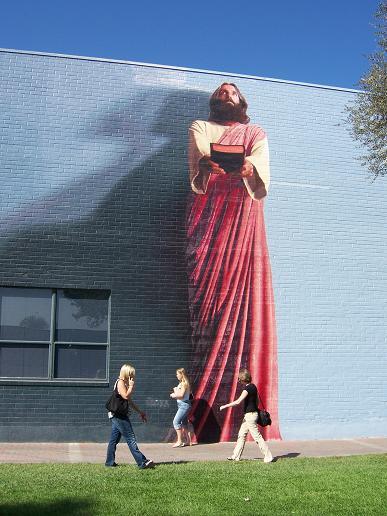No, not Jimmy Akin (this time). The other JA–John Allen. He explains:
My next book is titled "The Upside Down Church," a sort of sneak preview of Catholic history in the 21st century. I outline a series of mega-trends which I believe are turning the church on its head, especially with respect to the dominant paradigms in the 40-plus years since the close of the Second Vatican Council (1962-65). In order for that analysis to hold water, however, I have to identify these mega-trends correctly.
By "mega-trend," I mean a deep impulse shaping Catholic thought and life at the universal level, a sort of "tectonic plate" whose shifts lie beneath the fault lines and upheavals of the present. I have in mind not single issues, but currents of history which cause some issues to rise in importance and others to fall. A mega-trend, by the way, does not have to be specifically Catholic, but rather something that affects Catholicism in a significant way. For example, the rise of Islam, especially its more radical forms, certainly belongs on the list.
My request is this: Read this list, and ponder it. Are there major forces I’ve neglected? Are there items here that don’t belong? Does this list correspond with your own sense of what’s happening in the church?
The items on his list (in summary form and no particular order) are:
The North/South Shift
The Quest for Catholic Identity
The Rise of Islam
The Movements
The Biotech Revolution
The Wireless World
The Wojtyla Revolution
Globalization
Polarization and Its Discontents
The Sexual Abuse Crisis
READ THE ARTICLE FOR MORE INFO ON EACH.
Of the trends that JA lists, the ones that leap out at me as having the largest impact on the next century are the North/South shift, the rise of Islam, the biotech revolution, and the wireless world. I’ve already commented on the blog on the impact that each of these will have, though without using JA’s labels for them. Globalization will be a big one, too.
What he calls the Wojtyla revolution–basically pointing the Church away from post-Vatican II navel gazing and tinkering and instead engaging the culture–may have a large impact on 21st century Catholicism, but this depends on the course charted by future popes in a way that the other trends do not. It was the actions of recent popes that were in significant measure responsible for the situation that developed prior to "the Wojtyla revolution" (e.g., Paul VI’s ineffectual response to the Humanae Vitae dissenters) and an unsteady hand from future popes could undo the gains of the revolution.
I’m less sure about the polarization and the sexual abuse crisis and whether they will play century-spanning roles in shaping the Church. Some amount of polarization in the Church has always been with us (read 1 Corinthians) and always will be with us. The kind of extreme, ideological polarization that we’ve seen in the last number of years, however, strikes me as something that has already begun to abate–due to the Wojtyla revolution and due to the fact that one of the major poles–liberal Catholicism–is inherently unstable.
The ideological equivalent of the Roe Effect is at work here. Religious liberalism of the kind that we’ve dealt with of late is and has in every context in Christendom proved itself to be an unviable in the long-term. It doesn’t reproduce itself, which is why religious orders that have been infected with it are dying, while those that have resisted it are surviving or growing. One can’t have a strongly polarized environment–at least one gravitating around two poles–if one pole evaporates to the point that it is no longer a serious ideological competitor to the other.
There will still be polarization, but we’ve already likely seen the high water mark of liberal dissent in the Church–as long as future popes keep a steady hand on matters.
As far as sexual scandal goes, I think that there is significant potential for future damage, but I suspect that it will change form somewhat. We may have (in the English-speaking world) seen the high water mark of the scandal of priests having sexual relations with minors. How widespread that problem has been outside the English-speaking world, I don’t know. What I suspect is that, while there may be periodic flare-ups of scandal involving minors, that the really big scandal is one that the media has yet to frame in such a way that it reaches critical mass. That scandal will be sexual relations between priests and other consenting adults. In particular, I would anticipate three kinds of scandals that, while there are precedents, have not yet exploded the way the sexual abuse crisis did:
1) Heterosexual priests living in concubinage and fathering children, particularly in the developing world.
2) Lay ex-lovers (both hetero- and homosexual), particularly in the developed world, who finger clerical paramours (some of whom may have pressured them into having abortions)
3) Rings of homosexual clerics who have colluded to further each others’ interests (as well as having sex with each other) and who have committed a variety of crimes–up to and including murder–to protect those in the ring from exposure.
None of this, incidentally, will be unique to the Catholic Church. This stuff is part of the fallen human condition, and the exact same things happen in non-Catholic churches and non-Christian religions and in secular society. But becaue of the Church’s commitment to celibacy, the taste of the press for scandal (which is stronger even than its desire to promote non-traditional sexual mores), and its anti-Catholic animus, I expect to see particular attention focused on each of these three areas in the next century.
Needless to say, the quicker the Church cleans up the problems mentioned above and the sources feeding them, such as ordination of homosexuals to the priesthood, the more the effects can be blunted.
Let’s keep the century ahead in prayer.

